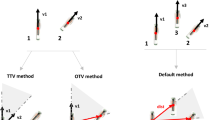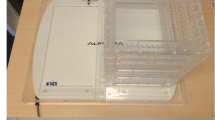Abstract
Purpose
To evaluate the applicability of the Calypso® wireless transponder tracking system (Varian Medical Systems Inc., USA) for real-time tumor motion tracking during surgical procedures on tumors in non-rigid target areas. An accuracy assessment was performed for an extended electromagnetic field of view (FoV) of 27.5 × 27.5 × 22.5 cm (which included the standard FoV of 14 × 14 × 19 cm) in which 5DOF wireless Beacon® transponders can be tracked.
Methods
Using a custom-made measurement setup, we assessed single transponder relative accuracy, absolute accuracy and jitter throughout the extended FoV at 1440 locations interspaced with 2.5 cm in each orthogonal direction. The NDI Polaris Spectra optical tracking system (OTS) was used as a reference. Measurements were taken in a room without surrounding distorting factors and repeated in an operating room (OR). In the OR, the influence of a carbon fiber and regular stainless steel OR tabletop was investigated.
Results
The calibration of the OTS and transponder system resulted in an average root-mean-square error (RMSE) vector of 0.03 cm. For both the standard and extended FoV, all accuracy measures were dependent on transponder to tracking array (TA) distances and the absolute accuracy was also dependent on TA to OR tabletop distances. This latter influence was reproducible, and after calibrating this, the residual error was below 0.1 cm RMSE within the entire standard FoV. Within the extended FoV, this residual RMSE did not exceed 0.1 cm for transponder to TA distances up to 25 cm.
Conclusion
This study shows that transponder tracking is promising for accurate tumor tracking in the operating room. This applies when using the standard FoV, but also when using the extended FoV up to 25 cm above the TA, substantially increasing flexibility.







Similar content being viewed by others
References
Senft C, Ulrich CT, Seifert V, Gasser T (2010) Intraoperative magnetic resonance imaging in the surgical treatment of cerebral metastases. J Surg Oncol 101:436–441
Ochs BG, Schreiner AJ, de Zwart PM, Stockle U, Gonser CE (2016) Computer-assisted navigation is beneficial both in primary and revision surgery with modular rotating-hinge knee arthroplasty. Knee Surg Sports Traumatol Arthrosc 24:64–73
Lango T, Tangen GA, Marvik R, Ystgaard B, Yavuz Y, Kaspersen JH, Solberg OV, Hernes TA (2008) Navigation in laparoscopy—prototype research platform for improved image-guided surgery. Minim Invasive Ther Allied Technol 17:17–33
Aschendorff A, Maier W, Jaekel K, Wesarg T, Arndt S, Laszig R, Voss P, Metzger M, Schulze D (2009) Radiologically assisted navigation in cochlear implantation for X-linked deafness malformation. Cochlear Implant Int 10(Suppl 1):14–18
Galloway RL, Herrell SD, Miga MI (2012) Image-guided abdominal surgery and therapy delivery. J Healthc Eng 3:203–228
Simpson AL, Kingham TP (2016) Current evidence in image-guided liver surgery. J Gastrointest Surg 20:1265–1269
Kingham TP, Scherer MA, Neese BW, Clements LW, Stefansic JD, Jarnagin WR (2012) Image-guided liver surgery: intraoperative projection of computed tomography images utilizing tracked ultrasound. HPB 14:594–603
Peterhans M, vom Berg A, Dagon B, Inderbitzin D, Baur C, Candinas D, Weber S (2011) A navigation system for open liver surgery: design, workflow and first clinical applications. Int J Med Robot 7:7–16
Su LM, Vagvolgyi BP, Agarwal R, Reiley CE, Taylor RH, Hager GD (2009) Augmented reality during robot-assisted laparoscopic partial nephrectomy: toward real-time 3D-CT to stereoscopic video registration. Urology 73:896–900
Sugimoto M, Yasuda H, Koda K, Suzuki M, Yamazaki M, Tezuka T, Kosugi C, Higuchi R, Watayo Y, Yagawa Y, Uemura S, Tsuchiya H, Azuma T (2010) Image overlay navigation by markerless surface registration in gastrointestinal, hepatobiliary and pancreatic surgery. J Hepatobiliary Pancreat Sci 17:629–636
Soler L, Nicolau S, Pessaux P, Mutter D, Marescaux J (2014) Real-time 3D image reconstruction guidance in liver resection surgery. Hepatobiliary Surg Nutr 3:73–81
Suwelack S, Rohl S, Bodenstedt S, Reichard D, Dillmann R, dos Santos T, Maier-Hein L, Wagner M, Wunscher J, Kenngott H, Muller BP, Speidel S (2014) Physics-based shape matching for intraoperative image guidance. Med Phys 41:111901
Collins JA, Weis JA, Heiselman JS, Clements LW, Simpson AL, Jarnagin WR, Miga MI (2017) Improving registration robustness for image-guided liver surgery in a novel human-to-phantom data framework. IEEE Trans Med Imaging 36:1502–1510
Rucker DC, Wu Y, Clements LW, Ondrake JE, Pheiffer TS, Simpson AL, Jarnagin WR, Miga MI (2014) A mechanics-based nonrigid registration method for liver surgery using sparse intraoperative data. IEEE Trans Med Imaging 33:147–158
Wild E, Teber D, Schmid D, Simpfendorfer T, Muller M, Baranski AC, Kenngott H, Kopka K, Maier-Hein L (2016) Robust augmented reality guidance with fluorescent markers in laparoscopic surgery. Int J Comput Assist Radiol Surg 11:899–907
Franz AM, Haidegger T, Birkfellner W, Cleary K, Peters TM, Maier-Hein L (2014) Electromagnetic tracking in medicine–a review of technology, validation, and applications. IEEE Trans Med Imaging 33:1702–1725
Wagner M, Gondan M, Zollner C, Wunscher JJ, Nickel F, Albala L, Groch A, Suwelack S, Speidel S, Maier-Hein L, Muller-Stich BP, Kenngott HG (2016) Electromagnetic organ tracking allows for real-time compensation of tissue shift in image-guided laparoscopic rectal surgery: results of a phantom study. Surg Endosc 30:495–503
Ungi T, Gauvin G, Lasso A, Yeo CT, Pezeshki P, Vaughan T, Carter K, Rudan J, Engel CJ, Fichtinger G (2016) Navigated breast tumor excision using electromagnetically tracked ultrasound and surgical instruments. IEEE Trans Biomed Eng 63:600–606
Willoughby TR, Kupelian PA, Pouliot J, Shinohara K, Aubin M, Roach M 3rd, Skrumeda LL, Balter JM, Litzenberg DW, Hadley SW, Wei JT, Sandler HM (2006) Target localization and real-time tracking using the Calypso 4D localization system in patients with localized prostate cancer. Int J Radiat Oncol Biol Phys 65:528–534
Zhu M, Bharat S, Michalski JM, Gay HA, Hou WH, Parikh PJ (2013) Adaptive radiation therapy for postprostatectomy patients using real-time electromagnetic target motion tracking during external beam radiation therapy. Int J Radiat Oncol Biol Phys 85:1038–1044
Zhang P, Hunt M, Happersett L, Yang J, Zelefsky M, Mageras G (2013) Robust plan optimization for electromagnetic transponder guided hypo-fractionated prostate treatment using volumetric modulated arc therapy. Phys Med Biol 58:7803–7813
Sawant A, Smith RL, Venkat RB, Santanam L, Cho B, Poulsen P, Cattell H, Newell LJ, Parikh P, Keall PJ (2009) Toward submillimeter accuracy in the management of intrafraction motion: the integration of real-time internal position monitoring and multileaf collimator target tracking. Int J Radiat Oncol Biol Phys 74:575–582
Kupelian P, Willoughby T, Mahadevan A, Djemil T, Weinstein G, Jani S, Enke C, Solberg T, Flores N, Liu D, Beyer D, Levine L (2007) Multi-institutional clinical experience with the Calypso system in localization and continuous, real-time monitoring of the prostate gland during external radiotherapy. Int J Radiat Oncol Biol Phys 67:1088–1098
Sonnenday CJ, Kaufman HS (2003) Use of an implantable marker for rapid intraoperative localization of nonpalpable tumors: a pilot study in a swine colorectal model. Surg Endosc 17:1927–1931
Nakamoto M, Ukimura O, Gill IS, Mahadevan A, Miki T, Hashizume M, Sato Y (2008) Realtime organ tracking for endoscopic augmented reality visualization using miniature wireless magnetic tracker. MIAR 5128:359–366
Janssen N, Eppenga R, Peeters MV, van Duijnhoven F, Oldenburg H, van der Hage J, Rutgers E, Sonke JJ, Kuhlmann K, Ruers T, Nijkamp J (2018) Real-time wireless tumor tracking during breast conserving surgery. Int J Comput Assist Radiol Surg 13:531–539
Nafis C, Jensen V, Von Jako R (2008) Method for evaluating compatibility of commercial electromagnetic (EM) microsensor tracking systems with surgical and imaging tables. Med Imaging 6918(691820):15
Franz AM, Schmitt D, Seitel A, Chatrasingh M, Echner G, Oelfke U, Nill S, Birkfellner W, Maier-Hein L (2014) Standardized accuracy assessment of the calypso wireless transponder tracking system. Phys Med Biol 59:6797–6810
Wen J (2010) Electromagnetic tracking for medical imaging. All Theses and Dissertations (ETDs) Paper 469, Washington University, Saint Louis
Balter JM, Wright JN, Newell LJ, Friemel B, Dimmer S, Cheng Y, Wong J, Vertatschitsch E, Mate TP (2005) Accuracy of a wireless localization system for radiotherapy. Int J Radiat Oncol Biol Phys 61:933–937
Elfring R, de la Fuente M, Radermacher K (2010) Assessment of optical localizer accuracy for computer aided surgery systems. Comput Aided Surg 15:1–12
Hummel J, Figl M, Kollmann C, Bergmann H, Birkfellner W (2002) Evaluation of a miniature electromagnetic position tracker. Med Phys 29:2205–2212
Lasso A, Heffter T, Rankin A, Pinter C, Ungi T, Fichtinger G (2014) PLUS: open-source toolkit for ultrasound-guided intervention systems. IEEE Trans Biomed Eng 61:2527–2537
Tukey JW (1977) Exploratory data analysis. Pearson, Don Mills
Nijkamp J, Schermers B, Schmitz S, de Jonge S, Kuhlmann K, van der Heijden F, Sonke JJ, Ruers T (2016) Comparing position and orientation accuracy of different electromagnetic sensors for tracking during interventions. Int J Comput Assist Radiol Surg 11:1487–1498
Nafis C, Jensen V, Beauregard L, Anderson P (2006) Method for estimating dynamic EM tracking accuracy of surgical navigation tools. Proc SPIE Int Soc Opt Eng 6141:152–167
Nijkamp J, Kuhlmann K, Sonke J-J, Ruers T (2016) Image-guided navigation surgery for pelvic malignancies using electromagnetic tracking and intra-operative imaging. Int J Comput Assist Radiol Surg 11:2
Acknowledgments
We would like to thank Ton Vlasveld for his help in fabricating the measurement setup and Professor Jan-Jakob Sonke for his insightful input. We would like to thank Koningin Wilhelmina Fonds - Alpe d’HuZes (NKI 2014-6596) for their funding.
Funding
This study was funded by KWF-Alpe d’HuZes (NKI 2014-6596)
Author information
Authors and Affiliations
Corresponding author
Ethics declarations
Conflict of interest
The Netherlands Cancer Institute that facilitated this research has a research agreement with Varian Medical Systems. Varian was not involved in the design or execution of the study.
Human and animal rights
This article does not contain any studies with human participants or animals performed by any of the authors.
Rights and permissions
About this article
Cite this article
Eppenga, R., Kuhlmann, K., Ruers, T. et al. Accuracy assessment of wireless transponder tracking in the operating room environment. Int J CARS 13, 1937–1948 (2018). https://doi.org/10.1007/s11548-018-1838-z
Received:
Accepted:
Published:
Issue Date:
DOI: https://doi.org/10.1007/s11548-018-1838-z




